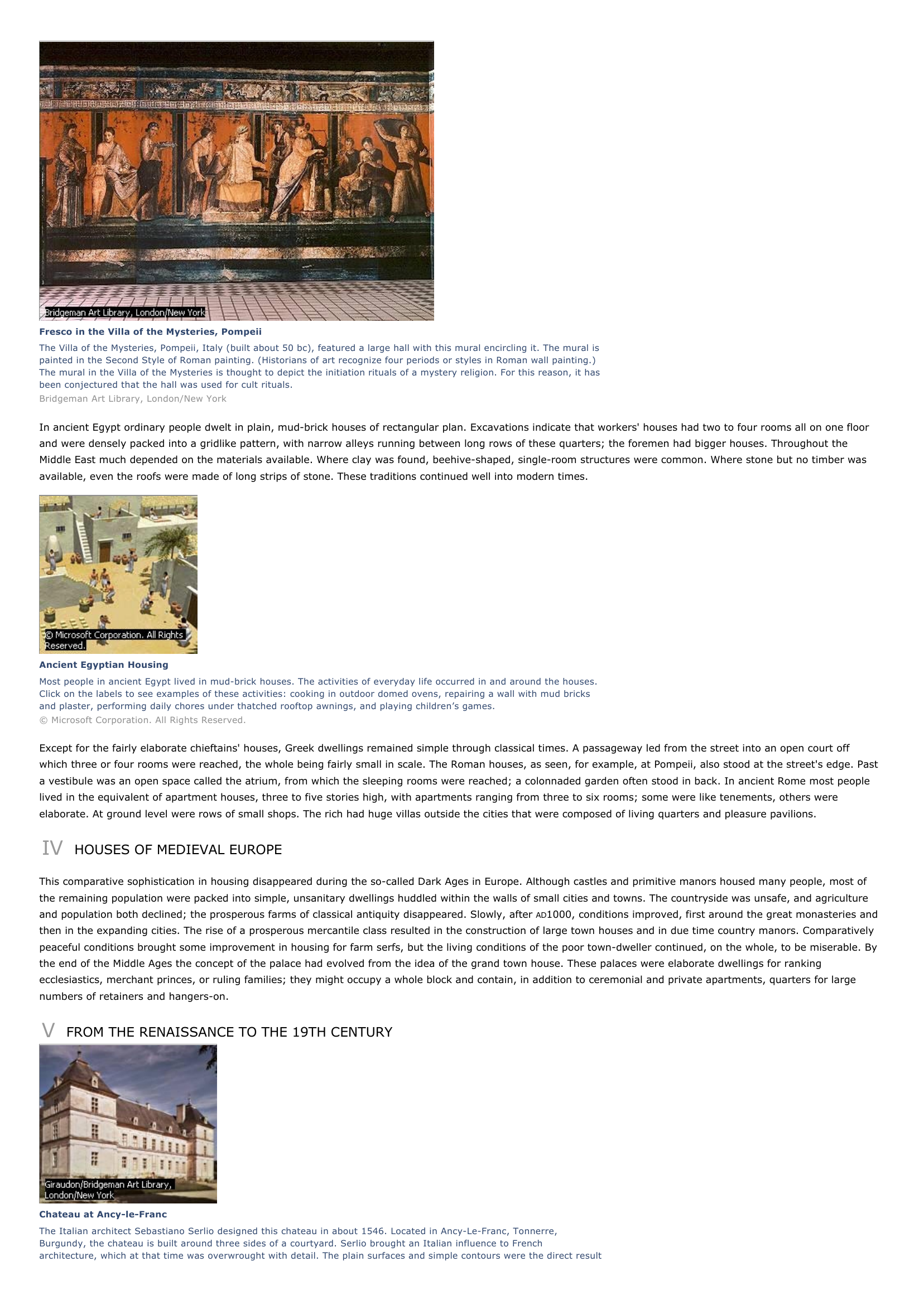House (architecture) I INTRODUCTION Trulli in Alberobello, Italy Alberobello, in the Apulia region of southeastern Italy, is noted for its unusual limestone houses known as trulli (from Greek trullos, dome).
Publié le 12/05/2013

Extrait du document


«
Fresco in the Villa of the Mysteries, PompeiiThe Villa of the Mysteries, Pompeii, Italy (built about 50 bc), featured a large hall with this mural encircling it.
The mural ispainted in the Second Style of Roman painting.
(Historians of art recognize four periods or styles in Roman wall painting.)The mural in the Villa of the Mysteries is thought to depict the initiation rituals of a mystery religion.
For this reason, it hasbeen conjectured that the hall was used for cult rituals.Bridgeman Art Library, London/New York
In ancient Egypt ordinary people dwelt in plain, mud-brick houses of rectangular plan.
Excavations indicate that workers' houses had two to four rooms all on one floorand were densely packed into a gridlike pattern, with narrow alleys running between long rows of these quarters; the foremen had bigger houses.
Throughout theMiddle East much depended on the materials available.
Where clay was found, beehive-shaped, single-room structures were common.
Where stone but no timber wasavailable, even the roofs were made of long strips of stone.
These traditions continued well into modern times.
Ancient Egyptian HousingMost people in ancient Egypt lived in mud-brick houses.
The activities of everyday life occurred in and around the houses.Click on the labels to see examples of these activities: cooking in outdoor domed ovens, repairing a wall with mud bricksand plaster, performing daily chores under thatched rooftop awnings, and playing children’s games.© Microsoft Corporation.
All Rights Reserved.
Except for the fairly elaborate chieftains' houses, Greek dwellings remained simple through classical times.
A passageway led from the street into an open court offwhich three or four rooms were reached, the whole being fairly small in scale.
The Roman houses, as seen, for example, at Pompeii, also stood at the street's edge.
Pasta vestibule was an open space called the atrium, from which the sleeping rooms were reached; a colonnaded garden often stood in back.
In ancient Rome most peoplelived in the equivalent of apartment houses, three to five stories high, with apartments ranging from three to six rooms; some were like tenements, others wereelaborate.
At ground level were rows of small shops.
The rich had huge villas outside the cities that were composed of living quarters and pleasure pavilions.
IV HOUSES OF MEDIEVAL EUROPE
This comparative sophistication in housing disappeared during the so-called Dark Ages in Europe.
Although castles and primitive manors housed many people, most ofthe remaining population were packed into simple, unsanitary dwellings huddled within the walls of small cities and towns.
The countryside was unsafe, and agricultureand population both declined; the prosperous farms of classical antiquity disappeared.
Slowly, after AD1000, conditions improved, first around the great monasteries and then in the expanding cities.
The rise of a prosperous mercantile class resulted in the construction of large town houses and in due time country manors.
Comparativelypeaceful conditions brought some improvement in housing for farm serfs, but the living conditions of the poor town-dweller continued, on the whole, to be miserable.
Bythe end of the Middle Ages the concept of the palace had evolved from the idea of the grand town house.
These palaces were elaborate dwellings for rankingecclesiastics, merchant princes, or ruling families; they might occupy a whole block and contain, in addition to ceremonial and private apartments, quarters for largenumbers of retainers and hangers-on.
V FROM THE RENAISSANCE TO THE 19TH CENTURY
Chateau at Ancy-le-FrancThe Italian architect Sebastiano Serlio designed this chateau in about 1546.
Located in Ancy-Le-Franc, Tonnerre,Burgundy, the chateau is built around three sides of a courtyard.
Serlio brought an Italian influence to Frencharchitecture, which at that time was overwrought with detail.
The plain surfaces and simple contours were the direct result.
»
↓↓↓ APERÇU DU DOCUMENT ↓↓↓
Liens utiles
- Nicolaus Copernicus I INTRODUCTION Nicolaus Copernicus (1473-1543), Polish astronomer, best known for his astronomical theory that the sun is at rest near the center of the universe, and that the earth, spinning on its axis once daily, revolves annually around the sun.
- Midas Greek A mythical king of Phrygia, an ancient region of central Asia Minor; son of the goddess Cybele and Gordius, from whom he inherited the throne.
- Pan Greek An ancient deity from the mountainous region of Arcadia, in Greece.
- Virgo (Virgin) Greek One of the constellations; sixth sign of the Zodiac, named for the maiden Erigone, who hanged herself from a tree after finding the grave of her murdered father, Icarius of Attica.
- Enyo (1) Greek A goddess of war, specifically known for sacking cities and towns of the enemy; daughter of Zeus and Hera; depicted as the sister, daughter, or mother of the war god Ares, often included as a companion of Ares when he went into battle.












